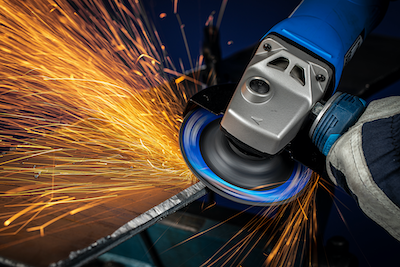'PFERDERGONOMICS' and CC-GRIND ROBUST grinding disc address physical strain in the workplace
Contributed by PFERD
Noise, dust and vibration emissions successfully reduced during grinding: using state-of-the-art tools, manufacturing companies can significantly improve working conditions and increase user satisfaction.
 Claus Genau, head of new product development / manufacturing and the central test facility at manufacturer PFERD, knows only too well how physical strain at the workplace can lead to health-related limitations among employees. “We’ve been looking closely into the stresses and strains that occur during grinding work, and especially at how to reduce vibration, noise and dust emissions and optimize haptic properties, since 2010 under our ‘PFERDERGONOMICS’ concept.”
Claus Genau, head of new product development / manufacturing and the central test facility at manufacturer PFERD, knows only too well how physical strain at the workplace can lead to health-related limitations among employees. “We’ve been looking closely into the stresses and strains that occur during grinding work, and especially at how to reduce vibration, noise and dust emissions and optimize haptic properties, since 2010 under our ‘PFERDERGONOMICS’ concept.”
Over the years, the company has acquired extensive knowledge of how to improve ergonomics. “This knowledge has permanently changed how we work, think and develop our products. We’ve been assessing and optimizing every PFERD tool with these points in mind ever since, right from the early stages of development,” he adds. The PFERDERGONOMICS philosophy has produced a wealth of new developments, including several innovations, which solve the problems that PFERD’s customers face and are designed to protect users’ health.
“The most common causes of work-related illnesses are still noise and dust emissions,” explains the development engineer. In Germany alone, around four to five million employees are exposed to hazardous noise levels in the workplace. The consequences range from hearing impairments through to a long-term incapacity for work. “In this respect, working conditions acts provide the foundation for protecting employees,” explains Genau. For employers and their safety officers, meeting these requirements presents an ever-growing challenge. This is because, while striving for economic efficiency and productivity, it is employees and their health and well-being at work that are always the first priority. “The result is a situation of seemingly divided interests, for which good solutions are needed.”
For this reason, customers are rethinking how they look at things. Before turning to personal measures such as ear defenders to protect users’ health, the first step must be to define appropriate technical measures. “Before protecting against noise, you need to prevent it from being generated in the first place,” says Genau, explaining the customers’ approach. “Noise-abating measures within the process itself, for example by using low-noise machines and drives or by adjusting the acoustics in the room, must always take precedence.” For this reason, many manufacturing companies are looking for ways to improve working conditions. One early candidate identified for this was the grinding process because it is often very loud and generates dust.
“PFERD conducted intensive research into these fields with PFERDERGONOMICS, and time and time again we were able to identify clear improvements,” says Genau. “This was most recently seen with our CC-GRIND ROBUST grinding disc, which produces considerably less noise during use than the grinding wheels used to date. This was also confirmed by noise measurements taken under operating conditions at our customers’ premises: noise emissions fell substantially from over 100 to around 94 dB(A) when using a corded angle grinder, and from over 96 to less than 89 dB(A) when using a cordless angle grinder.”
Similar results were obtained in comparative measurements with a trade association. “Due to its innovative design, the CC-GRIND ROBUST is generally the superior grinding tool in many different aspects, including when compared to the grinding wheel. The fact that it is constructed on the basis of a glass fibre-reinforced plastic pad makes the tool much lighter and means it is safe, robust and low-vibration during use.” Thanks to the optimized shape of the backer, the tool always makes the ideal amount of contact with the workpiece, which ensures high stock removal and is essential for fast work progress. “And because, technically speaking, this is not an electroplated grinding tool, but rather a coated abrasive, it also causes significantly less dust,” explains the department head. “Compared to the grinding process using a grinding wheel, the CC-GRIND ROBUST does not have bond and reinforcement elements that significantly contribute to dust creation.” The aggressiveness of the abrasive grit and the optimum contact angle to the workpiece also mean that the material creates less dust, “because we produce chips, not dust. And so, suddenly we came up with a remarkably simple logic: the larger and heavier the chips, the lower the risk of dust entering the lungs.”
Another advantage is how economically the ROBUST grinding discs work. “It’s about the stock removal rate and operating speed, but also the heat transfer onto the workpiece,” says the PFERD engineer. The CC-GRIND ROBUST tools delivered an impressive performance across the board in the practical tests, so much so that the colleagues who tested the grinding discs said they would like to start using them “sooner rather than later.”
Manufacturer PFERD was delighted with the good test results and to have received consistently positive feedback on such a high, expert level. “These are people who know what they are doing,” says Claus Genau. “And these opinions are important for us because they prove to us that, with the CC-GRIND ROBUST, we have developed a powerful, state-of-the-art tool that fulfils current requirements and helps employers to overcome the many challenges they face, including in the area of workplace safety.”











